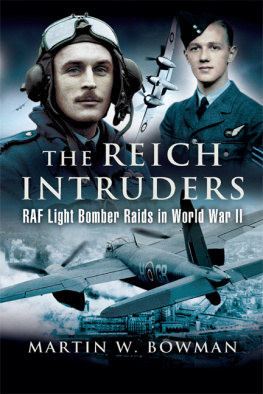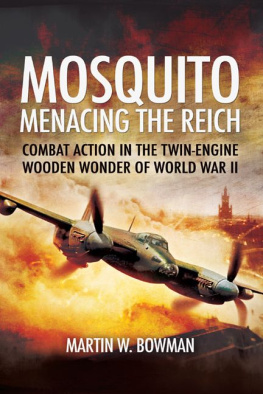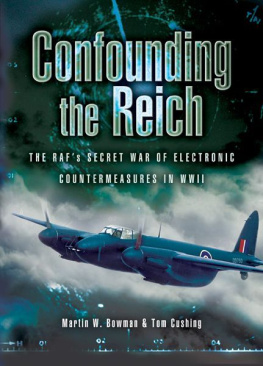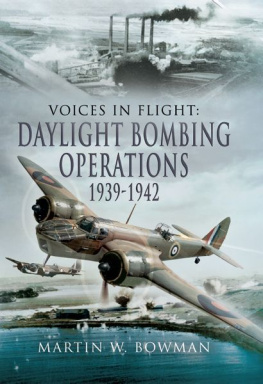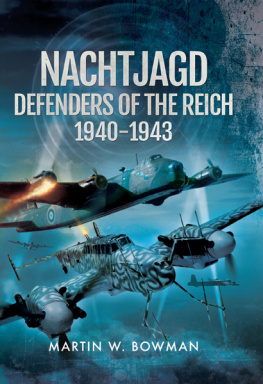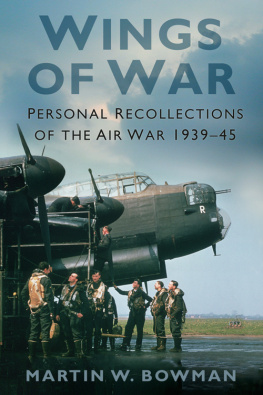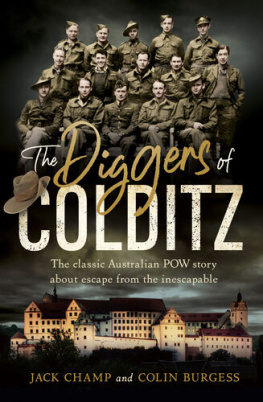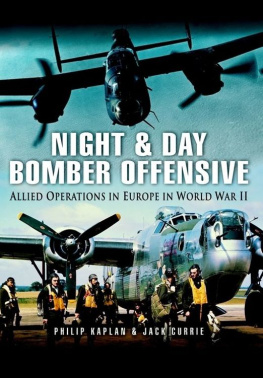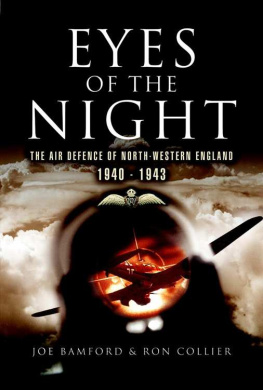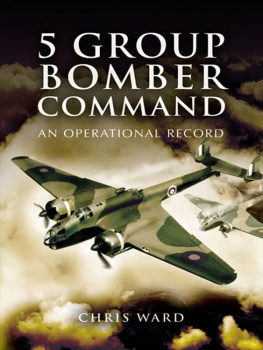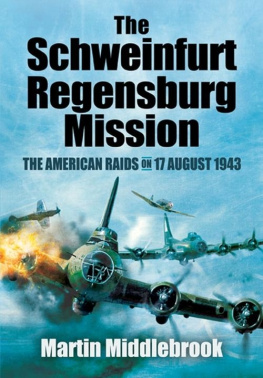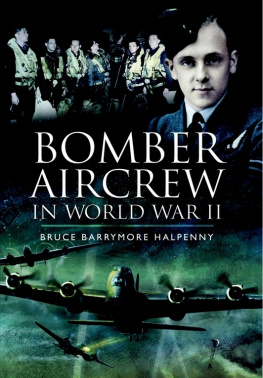First published in Great Britain in 2005 by
Pen & Sword Aviation
An imprint of
Pen & Sword Books Ltd
47 Church Street
Barnsley
South Yorkshire
S70 2AS
Copyright Martin W. Bowman, 2005
ISBN 1 84415 333 9
eISBN 9781783409655
The right of Martin W. Bowman to be identified as Author of this Work has been asserted, by him in accordance with the Copyright, Designs and Patents Act 1988.
A CIP catalogue record for this book is
available from the British Library
All rights reserved. No part of this book may be reproduced or transmitted in any form or by any means, electronic or mechanical including photocopying, recording or by any information storage and retrieval system, without permission from the Publisher in writing.
Printed and bound in England by
By CPI UK
Pen & Sword Books Ltd incorporates the Imprints of Pen & Sword Aviation,
Pen & Sword Maritime, Pen & Sword Military, Wharncliffe Local history,
Pen & Sword Select, Pen & Sword Military Classics and Leo Cooper.
For a complete list of Pen & Sword titles please contact
PEN & SWORD BOOKS LIMITED
47 Church Street, Barnsley, South Yorkshire, S70 2AS, England
E-mail: enquiries@pen-and-sword.co.uk
Website: www.pen-and-sword.co.uk
Contents
Acknowledgements
I must first thank Jim Dinty Moore DFC and the late John Bateman, both of whom graciously made available their precious squadron albums and photographs on more than one occasion; Mike Bailey, for his guidance, proofing and loan of photographs and reference books; Bob Collis, for his invaluable input of research material and advice; Paul McCue, Dr Theo Boiten, Kees Rijken and Paul Schepers, joint authors of Operation Oyster , in Holland and Eric Mombeek in Belgium; Les Bulmer; Jan Kloos in Switzerland; Julian Horn and Paul Lincoln of the Wartime Watton Museum; Ole Rnnest in Denmark; and last but by no means least, Sister Laurence Mary. All of these filled many gaps with valuable photographs and material. I am no less indebted to the following: Arthur Asker; Eric Atkins DFC* KW ( Krzyz Walecznych )*, Chairman, Mosquito Aircrew Association; Gerald Baker; Ralph Barker; Jack Bartley; the late Gordon Bell-Irving; The Rt Hon. Tony Benn MP; Philip J. Birtles, Leslie Bond; Roy J. A. Brookes JP, Chairman, 88 Squadron Association; Nigel Buswell; Arthur Butterworth; Michael Carreck DFC; Squadron Leader Ray Chance; Wilf J. Clutton; Maurice A. Collins DFC DFM; W. G. Bill Cooper, 137/139 All Ranks Association; William F. Bill Corfield FRICS FAAV ACIArb; Tom Cushing; Squadron Leader Mike Daniels; Rene Deeks; Reg Everson; John Foreman; Bob Gallup; GMS Enterprises; Ken Godfrey; Ted Gorman; Peter B. Gunn; Hans de Haan; Nicholas Heffer; Dudley Hemmings; H. C. Gary Herbert RAAF DFC; Wilf Jessop; Bernard M. Job; Jack Lub; Jock MacDonald; Graham Digger Magill; Peter Mallinson; Squadron Leader Hugh Milroy RAF; Eric Mombeek; Norma Moore; P. D. Morris; W. J. Morris; Aubrey Niner; Simon Parry; Squadron Leader Charles Patterson DFC DSO; Jack and Freddie Peppiatt; Chief Technician Steve Pope; Tony Rudd; Peter Saunders; Squadron Leader Malcolm Scott DFC; Steve Snelling, EDP, Norwich; Jerry Scutts; Mrs Vera Sherring; A. M. J. Smith; Steve Smith; Herbert E. Tappin; Group Captain Bill Taylor; Andy Thomas; Slim Trew; Henk F. Van Baaren; Colin Ginger Walsh; Kenneth A. I. Warwood; Colin Waugh; and Tony Wilson.
Martin Bowman Norwich, 2005.
CHAPTER ONE
Full Cry
Out of England, over France ,
Three by three, in swift advance ,
Eager as at the first cock-crow ,
Let the hunting Blenheims go!
Full Cry by Flight Lieutenant Anthony Richardson RAFVR,
Adjutant, 107 Squadron
T here is quite a panic on here. We are going away today to WATTON. About twenty miles from Norwich. The reports of the place are not so hot. Will write soon as we get settled down now. Cheerio. We are off in about 1 hour. With love
So wrote 18-year-old Leading Aircraftsman (LAC) Freddie Thripp of 82 Squadron, in an urgent postcard home in August 1939. His squadron was one of ten in 2 (Bomber) Group, which had been formed on 20 March 1936. Now, in August 1939, war with Germany, which had been avoided at Munich in 1938, loomed large and 2 Group would be in the front line long before a large part of the rest of Britains armed forces. With headquarters at Wyton, Cambridgeshire, the group numbered five wings: 70 Wing at Upper Heyford controlled 18 and 57 Squadrons; 79 Wing at Watton, 21 and 82 Squadrons; 81 Wing at West Raynham, Norfolk, 90 and 101 Squadrons; 82 Wing at Wyton, 114 and 139 Squadrons; and 83 Wing at Wattisham, 107 and 110 Squadrons. All 2 Group squadrons were equipped with the twin-engined Bristol Blenheim Mk I or Mk IV (21, 18 and 57 Squadrons were still in the process of converting to the IV). Britain and her allies were, however, ill equipped to prevent a repetition of the fate that had already befallen Poland. Four of these wings formed the 2nd Echelon of the Advanced Air Striking Force while 70 Wing was earmarked for service in France supporting the British Expeditionary Force (BEF) along with squadrons of obsolete single-engined Fairey Battles. The Battle and Blenheim monoplane bombers were a vast improvement on the Hind biplane bombers that had equipped 2 Group in the mid-1930s but the Air Ministry seemed to have little conception of modern fighter tactics. A Blenheim cost 20,000 and sadly was about to be exposed as an expensive machine in terms of lives spent for little offensive reward (it could only carry 1,000 lb bombs internally). Apart from a fixed forward-firing gun in the wing operated by the pilot and another under the nose, there was a rather ancient Vickers gas-operated .303 machine gun in a dorsal turret, which was fed from circular ammunition pans, each of which contained 100 rounds. Spare pans were clipped on to the side of the turret. The crew of three comprised the pilot (an officer or flight sergeant), observer (normally a senior NCO) and upper gunner (usually an aircraftsman 1st or 2nd class, leading aircraftsman or corporal). AC1 (later sergeant) Jack Bartley, a wireless operator/air gunner (WOp/AG) on Blenheims, recalls.
The pilot, navigator and the air-gunner lived in three entirely separate social worlds. The only time the SNCOs and the officers met was once a month on invitation to the opposite mess. The airmen only met the officers at the annual airmens Xmas dinner when the officers traditionally served the meal. The SNCOs and officers enjoyed a high standard of living in their respective messes, while the Wireless Operators/Air Gunners lived in barrack rooms together with the lowest ACHs who might have cleaned the toilets. Even when waiting for take-off during a stand-by we would be in separate crew rooms in the hangar. Prior to June 1940 (when all operational aircrew below the rank were promoted to Sergeant), WOp/AGs were other ranks (AC2, AC1, LAC and Corporal). As such they were subject to normal station duties including guards, which could mean you were flying by day sitting behind a machine gun and slinging a rifle for four-hour spells patrolling the dispersed aircraft through the icy nights that the 193940 winter produced. The one privilege we enjoyed apart from the princely sum of an additional shilling [5p] per day flying pay plus sixpence [2p] a day for the Flying Bullet Air Gunner badge, was a monthly two-day leave pass.

Blenheim I aircraft of 21 Squadron at RAF Watton in June 1939. L1345 went on to serve with 90 and 114 Squadrons and 13 OTU until it went to Finland on 21 July 1940. The Finnish air force acquired ninety-seven Blenheim Is and they were used in the war with the Soviet Union, which began in November 1939. ( Wartime Watton Museum )

